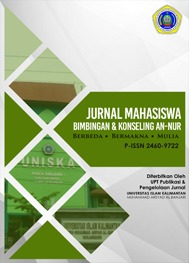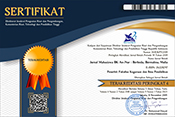DESKRIPSI GANGGUAN DISLEKSIA PADA SISWA SEKOLAH DASAR KECAMATAN SEGEDONG
(1) IKIP PGRI Pontianak
(2) IKIP PGRI Pontianak
(3) IKIP PGRI Pontianak
(*) Corresponding Author
Sari
Students who have learning difficulties are different from children who have learning problems. learning difficulties in this study focused on impaired children's ability to distinguish letters and write numbers. One of the learning difficulties experienced by students is dyslexia. The purpose of this study was to determine student learning difficulties (dyslexia) of elementary school students in Segedong District. The method used in this research is descriptive method. The stages of the method in this study were in the form of instrument design, interview data collection, observation and data analysis. Based on the results of the study there were 10 students who had symptoms of dyslexia out of a total of 133 students or 7.5% of students who had dyslexia. Most symptoms
Kata Kunci
Teks Lengkap:
PDFReferensi
Aldakhil, A. F., Ebrahim, M. T., & Gadelrab, H. F. (2023). Diagnostic survey of dyslexia and accompanying behavioral indicators in primary school students in Saudi Arabia. Research in Developmental Disabilities, 134, 104424. https://doi.org/https://doi.org/10.1016/j.ridd.2023.104424
Alias, N. A., & Dahlan, A. (2015). Enduring Difficulties: The Challenges of Mothers in Raising Children with Dyslexia. Procedia - Social and Behavioral Sciences, 202(December 2014), 107–114. https://doi.org/10.1016/j.sbspro.2015.08.213
Diswantika, N., Kartadinata, S., Supriatna, M., & Indonesia, U. P. (2022). Jurnal Mahasiswa BK An-Nur : Berbeda , Bermakna , Mulia Volume 8 Nomor 1 Tahun 2022 Tersedia Online : https://ojs.uniska-bjm.ac.id/index.php/AN-NUR STKIP-PGRI Bandar Lampung Dipublikasikan Oleh : UPT Publikasi dan Pengelolaan Jurnal Universitas Islam Kali. 8, 57–73. https://ojs.uniska-bjm.ac.id/index.php/AN-NUR/article/viewFile/8638/4681
Gabriel, R. E. (2020). Converting to Privatization: A Discourse Analysis of Dyslexia Policy Narratives. American Educational Research Journal, 57(1), 305–338. https://doi.org/10.3102/0002831219861945
Gooch, D., Hulme, C., Nash, H. M., & Snowling, M. J. (2014). Comorbidities in preschool children at family risk of dyslexia. Journal of Child Psychology and Psychiatry and Allied Disciplines, 55(3), 237–246. https://doi.org/10.1111/jcpp.12139
Hebert, M., Kearns, D. M., Hayes, J. B., Bazis, P., & Cooper, S. (2018). Why children with dyslexia struggle with writing and how to help them. Language, Speech, and Hearing Services in Schools, 49(4), 843–863. https://doi.org/10.1044/2018_LSHSS-DYSLC-18-0024
Hsb, N. S. (2021). Pendampingan Orang Tua untuk Menstimulus Belajar Anak Disleksia. Jurnal Anifa, 1(1), 1–15. https://doi.org/10.32505/anifa.v1i1.2427
Kimel, E., Weiss, A. H., Jakoby, H., Daikhin, L., & Ahissar, M. (2020). Short-term memory capacity and sensitivity to language statistics in dyslexia and among musicians. Neuropsychologia, 149, 107624. https://doi.org/10.1016/j.neuropsychologia.2020.107624
Kirby, P. (2020). Dyslexia debated, then and now: a historical perspective on the dyslexia debate. Oxford Review of Education, 46(4), 472–486. https://doi.org/10.1080/03054985.2020.1747418
Leitão, S., Dzidic, P., Claessen, M., Gordon, J., Howard, K., Nayton, M., & Boyes, M. E. (2017). Exploring the impact of living with dyslexia: The perspectives of children and their parents. International Journal of Speech-Language Pathology, 19(3), 322–334. https://doi.org/10.1080/17549507.2017.1309068
Lopes, J. (2012). Biologising reading problems: The specific case of dyslexia. Contemporary Social Science, 7(2), 215–229. https://doi.org/10.1080/21582041.2012.692098
Muin, J. A., Riyanto, & Wibowo, S. B. (2020). Teacher competencies for dyslexia students. Universal Journal of Educational Research, 8(3), 904–908. https://doi.org/10.13189/ujer.2020.080322
Nik Haryanti, Muhibbudin, M., & Imam Junaris. (2022). Analisis Kesulitan Belajar Siswa (Disleksia dan Disgrafia) di Masa Pandemi Covid-19. Journal of Instructional and Development Researches, 2(1), 7–16. https://doi.org/10.53621/jider.v2i1.60
Ogunsola, ’Bukunmi A. (2018). Teacher’s Qualification and Dyslexia Identification in Primary Schools in Oyo State, Nigeria. Africa Education Review, 15(4), 36–66. https://doi.org/10.1080/18146627.2017.1302308
Palser, E. R., Morris, N. A., Roy, A. R. K., Holley, S. R., Veziris, C. R., Watson, C., Deleon, J., Miller, Z. A., Miller, B. L., Gorno-Tempini, M. L., & Sturm, V. E. (2021). Children with developmental dyslexia show elevated parasympathetic nervous system activity at rest and greater cardiac deceleration during an empathy task. Biological Psychology, 166(September), 108203. https://doi.org/10.1016/j.biopsycho.2021.108203
Rahmwati, L. E., Purnomo, E., Hadi, D. A., & Wulandari, M. D. (2022). Studi Eksplorasi Bentuk-Bentuk Gejala Disleksia pada Anak. 6(5), 4003–4013. https://doi.org/10.31004/obsesi.v6i5.2495
Rofiah, N. H. (2015). Proses Identifikasi: Mengenal Anak Kesulitan Belajar Tipe Disleksia Bagi Guru Sekolah Dasar Inklusi. Inklusi, 2(1), 109. https://doi.org/10.14421/ijds.020110
Rosmawati, D., & Juni Samodra, Y. T. (2021). c. JPPTK: Jurnal Pendidikan Pembelajaran & Penelitian Tindakan, 1(1), 92–99. https://doi.org/10.53813/jpptk.v1i1.11
Safitri, T. (2021). Analisis Kesulitan Belajar Siswa Di Sd Negeri 14 Tangerang. Journal Mathematics Education Sigma [JMES], 2(1), 30–35. https://doi.org/10.30596/jmes.v2i1.6753
Sinaga, R., & Tanjung, D. S. (2019). Efektifitas Penggunaan Interactive Educational Multimedia Learning Berbasis Teori Kognitif terhadap Dyslexic Student di Sekolah Dasar. Jurnal Guru Kita, 3(4), 338–341.
DOI: http://dx.doi.org/10.31602/jmbkan.v9i1.10187
Refbacks
- Saat ini tidak ada refbacks.
Akun Akademik Anda Terhubung dengan :
Didedikasikan Untuk:
Jurnal Mahasiswa BK An-Nur : Berbeda, Bermakna, Mulia disseminated below Lisensi Creative Commons Atribusi 4.0 Internasional.

















